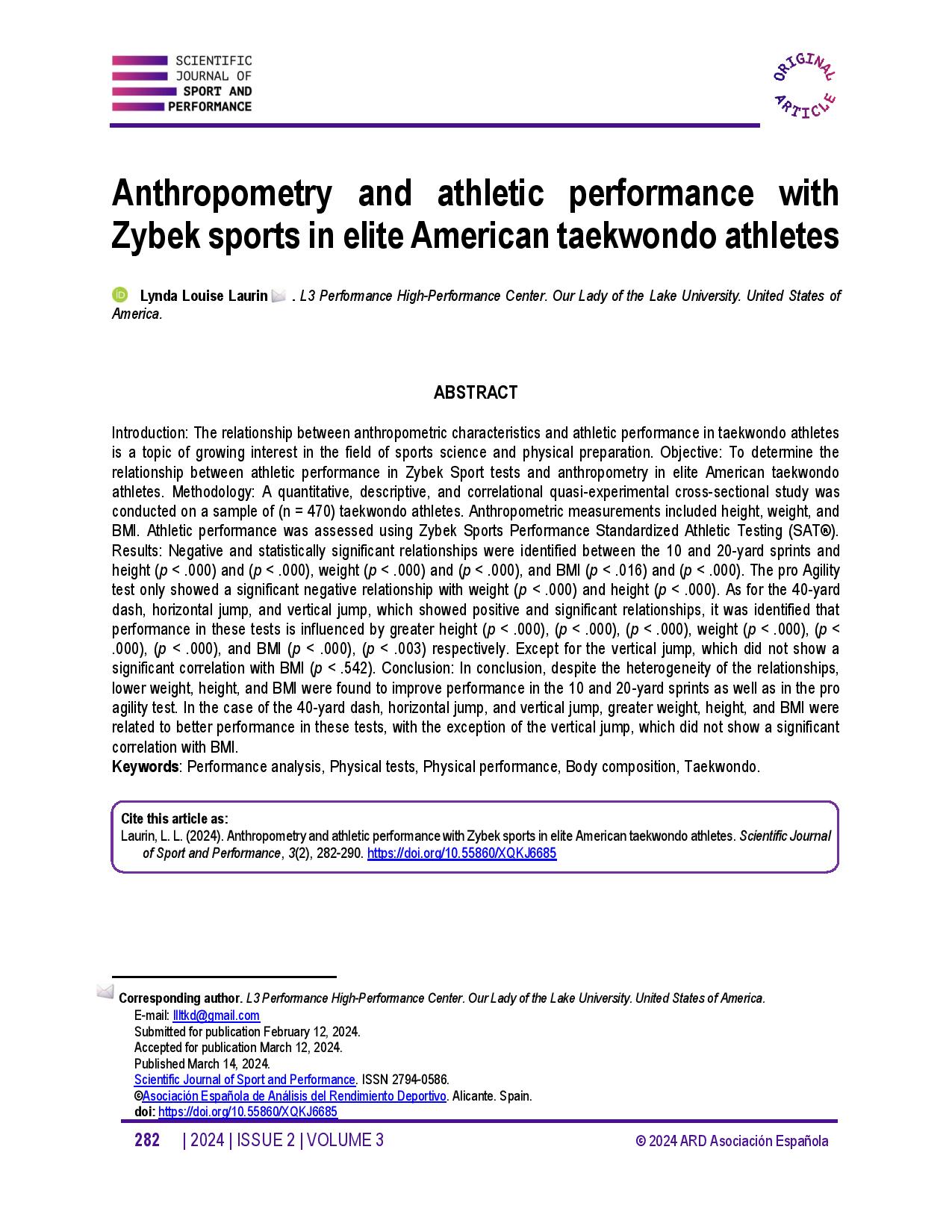Anthropometry and athletic performance with Zybek sports in elite American taekwondo athletes
Main Article Content
Abstract
Introduction: The relationship between anthropometric characteristics and athletic performance in taekwondo athletes is a topic of growing interest in the field of sports science and physical preparation. Objective: To determine the relationship between athletic performance in Zybek Sport tests and anthropometry in elite American taekwondo athletes. Methodology: A quantitative, descriptive, and correlational quasi-experimental cross-sectional study was conducted on a sample of (n = 470) taekwondo athletes. Anthropometric measurements included height, weight, and BMI. Athletic performance was assessed using Zybek Sports Performance Standardized Athletic Testing (SAT®). Results: Negative and statistically significant relationships were identified between the 10 and 20-yard sprints and height (p < .000) and (p < .000), weight (p < .000) and (p < .000), and BMI (p < .016) and (p < .000). The pro Agility test only showed a significant negative relationship with weight (p < .000) and height (p < .000). As for the 40-yard dash, horizontal jump, and vertical jump, which showed positive and significant relationships, it was identified that performance in these tests is influenced by greater height (p < .000), (p < .000), (p < .000), weight (p < .000), (p < .000), (p < .000), and BMI (p < .000), (p < .003) respectively. Except for the vertical jump, which did not show a significant correlation with BMI (p < .542). Conclusion: In conclusion, despite the heterogeneity of the relationships, lower weight, height, and BMI were found to improve performance in the 10 and 20-yard sprints as well as in the pro agility test. In the case of the 40-yard dash, horizontal jump, and vertical jump, greater weight, height, and BMI were related to better performance in these tests, with the exception of the vertical jump, which did not show a significant correlation with BMI.
Article Details

This work is licensed under a Creative Commons Attribution-NonCommercial-ShareAlike 4.0 International License.
References
Arazi, H., Hosseinzadeh, Z., & Izadi, M. (2016). Relationship between anthropometric, physiological and physical characteristics with success of female taekwondo athletes. Turkish Journal of Sport and Exercise, 18(2), 69-75. https://doi.org/10.15314/tjse.94871 DOI: https://doi.org/10.15314/tjse.94871
Benavides-Roca, L., Salazar Orellana, C., & Díaz Coria, G. (2021). Relación entre las características antropométricas de masa muscular de extremidad inferior y la potencia de salto de jóvenes deportistas. MHSalud, 18(2), 134-150. https://doi.org/10.15359/mhs.18-2.9 DOI: https://doi.org/10.15359/mhs.18-2.9
Borba, DDA, Ferreira-Júnior, JB, Brant, VM, Guimarães, JB y Vieira, CA (2016). ¿Cuál es la contribución de las características antropométricas a la velocidad de carrera de corta distancia? Pensamiento práctico (Impr.) , 423-431. https://doi.org/10.5216/rpp.v19i2.40690 DOI: https://doi.org/10.5216/rpp.v19i2.40690
Bridge, C. A., Ferreira da Silva Santos, J., Chaabene, H., Pieter, W., & Franchini, E. (2014). Physical and physiological profiles of taekwondo athletes. Sports Medicine, 44, 713-733. https://doi.org/10.1007/s40279-014-0159-9 DOI: https://doi.org/10.1007/s40279-014-0159-9
Campos, F. A., Morine, D., Avakian, P., Fernandes, C. A., Aoki, M. S., Moreira, A., ... & de Combate, M. (2009). Perfil antropométrico de atletas de taekwondo de alto rendimento. In Anais III Congresso de Ciência do Desporto. Campinas: FEF.
Declaración Helsinki, & World Medical Association. (1975). Declaracion de Helsinki. Principios éticos para las investigaciones médicas en seres humanos. Tokio-Japón: Asociación Médica Mundial.
Formalioni, A., Antunez, B. F., Vecchio, F. B. D., Cabistany, L. D., Coswig, V. S., Letieri, R. V., & Fukuda, D. H. (2020). Anthropometric characteristics and physical performance of taekwondo athletes. Revista Brasileira de Cineantropometria & Desempenho Humano, 22, e55697. https://doi.org/10.1590/1980-0037.2020v22e55697 DOI: https://doi.org/10.1590/1980-0037.2020v22e55697
Gillen, Z. M., Shoemaker, M. E., Mckay, B. D., & Cramer, J. T. (2019). State population influences athletic performance combine test scores in high school-aged American football players. International journal of exercise science, 12(6), 256.
Junior, N. K. M., Ascanio, W. J. A., Padilla, J., & Ortiz, P. (2020). Características antropométricas e do salto vertical de jovens karatecas. Edu-física. com, 12(25).
Laurin, L. L. (2021). The Relationship between Taekwondo Athletes' and Performance as Measured by SAT® Peak Performance, National Ranking, and Grit. Our Lady of the Lake University.
Leutzinger, T. J., Gillen, Z. M., Miramonti, A. M., McKay, B. D., Mendez, A. I., & Cramer, J. T. (2018). Anthropometric and athletic performance combine test results among positions within grade levels of high school-aged American football players. The Journal of Strength & Conditioning Research, 32(5), 1288-1296. https://doi.org/10.1519/JSC.0000000000002481 DOI: https://doi.org/10.1519/JSC.0000000000002481
Norton, K. I. (2018). Standards for anthropometry assessment. Kinanthropometry and exercise physiology, 4, 68-137. https://doi.org/10.4324/9781315385662-4 DOI: https://doi.org/10.4324/9781315385662-4
Oficina para la Protección de Sujetos Humanos (OHRP). (1974). 45 CFR Parte 46: Política Federal para la Protección de Sujetos Humanos. Retrieved from [Accessed March 04, 2024]: https://www.hhs.gov/ohrp/regulations-and-policy/regulations/45-cfr-46/index.html
Ojeda-Aravena, A., Azocar-Gallardo, J., Galle, F., & García-García, J. M. (2020). Relación entre las características de la composición corporal y el rendimiento físico general y específico en competidores de taekwondo chilenos de nivel nacional de ambos sexos: un estudio observacional. Revista Española de Nutrición Humana y Dietética, 24(2), 154-164. https://doi.org/10.14306/renhyd.24.2.969 DOI: https://doi.org/10.14306/renhyd.24.2.969
Peña-Sanchez, C., Mieles-Ramírez, M. R., & Patiño-Palma, B. E. (2022). Análisis del somatotipo en el taekwondo. Revisión de la literatura. Revista Investigación en Salud Universidad de Boyacá, 9(1), 95-114. https://doi.org/10.24267/23897325.763 DOI: https://doi.org/10.24267/23897325.763
Pieter, W. (2009). Taekwondo. Combat sports medicine, 263-286. https://doi.org/10.1007/978-1-84800-354-5_15 DOI: https://doi.org/10.1007/978-1-84800-354-5_15
Toro-Román, V., Siquier-Coll, J., Bartolomé, I., Grijota, F. J., Maynar, M., & Muñoz, D. (2021). relaciones entre la composición corporal y las pruebas de velocidad, aceleración y cambios de dirección en estudiantes universitarios. Journal of Sport and Health Research, 13(1), 67-78.
Vargas, P. C., Vargas, G. A. A., & Gerardo, A. (2010). Perfil de rasgos psicológicos para el rendimiento deportivo en hombres y mujeres practicantes de taekwondo. Revista iberoamericana de psicología del ejercicio y el deporte, 5(2), 253-265.
Villalba, T. F. R., Morocho, L. E. S., & Frómeta, E. R. (2018). Indicadores antropométricos básicos para la detección de posibles talentos en el taekwondo ecuatoriano de ambos sexos. Lecturas: educación física y deportes, 23(242), 95-107.
Wheeler, K., Nolan, E., & Ball, N. (2012). Can anthropometric and physiological performance measures differentiate between Olympic selected and non-selected taekwondo athletes. International Journal of Sports Science and Engineering, 6(3), 175-183.




